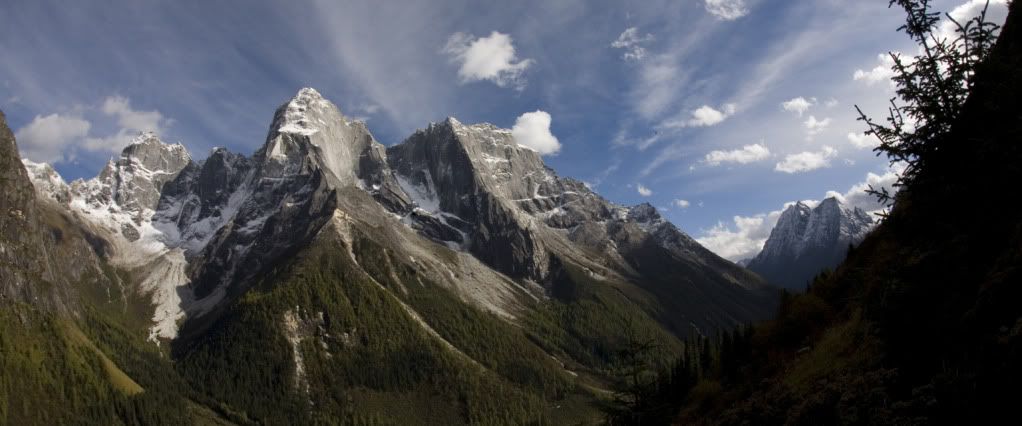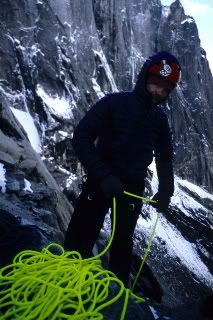
"During the month of October 2009, Pat Goodman and I traveled to China's Sichuan Province to attempt the unclimbed Seerdengpu. West of Mt. Siguniang, Seerdengpu is a sulking behemoth of a mountain. We approached through the Shuangqiao Valley, via a tour bus, which drives tourists and photographers directly beneath the west face.
Our first glimpse of Seerdengpu, gained as we stepped off the bus directly beneath the peak at about 4,000m altitude, was impressive and intimidating. A sign with a yak skull lashed to its top pointed to Seerdengpu and read Savage Peak. "Next stop, Torture Tower," I thought.
As we ferried our duffel bags to camp, I was struck by the novelty of the experience -- never had I been dropped off by public transport at the foot of an alpine objective. It was weirdly exciting. A typical approach by foot lends time to peer around corners and eye lines of weaknesses. Our approach was abrupt, and the spatial grandeur of the landscape was staggering. Our intended route was plastered with verglas and looked mean. Despite two years of studying photos of this peak and imagining our potential climb I felt suddenly unprepared and a good bit scared.
Another first was arriving at a climbing area only to be told by government officials that I needed a permit I did not have, that I would be unable to acquire a permit, and realize that to climb here meant taking a big legal risk.
As we hiked our climbing kit up to high camp below the northwest buttress, we ran into a team of three Swiss climbers who had the same trouble with permits. Back in Rilong, we'd been stopped at the entrance to the Shuangqiao Valley and told that we needed a special permit for climbing. In order to acquire a permit we would have to travel to Beijing and wait approximately two weeks. Our time would not allow for that. We were forced to sign and thumbprint a multi-page document stating that we would not mountaineer, ice climb or rock climb in the valley. The penalty was said to be confiscation of equipment and a $9,000 USD fine. This was the first season that permits have been required or enforced in the Mt. Siguninang Park, and the document we signed was dated June 30, 2009. It appears that this document was drafted in the wake of a couple tragic and high profile accidents in western China. The Swiss had also not found any information about permit requirements during their preparation. Independently, both teams had come to the same conclusion: we couldn't stomach traveling this far and turning home without an attempt at Seerdengpu.
We laid low in camp and watched our route on the northwest buttress. From a previous attempt the buttress was reported to be featureless and polished. The line was not obvious, but after days of spying it from different angles at different times of day we had pieced together a nebulous line of discontinuous crack systems. Though a few long sections looked blank our initial shock and apprehension were fading and the route-in our imaginations-was coming alive. The Swiss, initially considering an attempt on Seerdengpu turned their attention to a steep attractive wall behind Seerdengpu.
Rain fell, as did snow; the valley would fill with mist, and then clear. The weather was never violent; we heard only the occasional rumble of distant thunder. The rock would dry for an evening only to be covered in rime ice the next morning, then melt and stay soaking wet. After watching this cycle repeat itself a few times we became impatient, pulled high camp, and turned our attention to the southwest face in favor of sun and fast-drying rock.
We had ideas of potential lines, but nothing looked obvious. While hiking up the 1,000m scree approach I noticed a clean-looking crack system. We switched gears, jumped on it and found clean, solid granite and splitter crack systems, mostly hand-size and occasionally widening enough to jam a knee-mostly 5.8 and 5.9. The most difficult pitch of the climb, dubbed the "E5 Pitch", was a poorly-protected friction face (5.11?). We climbed within about 350 vertical meters of the summit to the "eyebrow"-the base of the first major ledge which holds snow. Here the angle eases off to the summit but the route finding did not look easy. We had boots, tools and crampons, ready to switch gears from rock climbing to alpine. However, an injury forced retreat-a descent that proved long and soggy.

Back on the valley floor a black Audi with tinted windows rolled up to Pat. The window slid down and a government official looked sternly at Pat, pointed at Seerdengpu and said: "No permit, no climb. No permit, no climb!"
We packed up to leave the following day. After 15 days of living in these mysterious and mist-shrouded mountains I found it physically difficult to leave. I was under their spell. This climb had been purely cerebral in the two years of planning and imagining. As we lived beneath and studied Seerdengpu the climb took on a ghostlike form. Then, what had been only a ghost, through 15 pitches, became a reality. This part-dream, part-reality climb was still alive and hungry in my mind. I could only stand to leave it behind after anesthetizing myself with the better part of a bottle of astringent rice liquor. I sped out the Shuangqiao Valley packed amongst clean tourists, my eyes glued to the road ahead."
—David Sharratt
Alpine style version of the MTV Cribs. "How do climbers keep from going insane while waiting for the weather to stabilize in the mountains?", you might ask yourself. Well here is one example - make a cheesy video!
0 comments:
Post a Comment